CAT Exam > CAT Questions > Answer the following question based on the in...
Start Learning for Free
Answer the following question based on the information given below.
A country XYZ is facing election in the current year. There are 5 political parties in the country contesting for the election namely P, Q, R, S and T. Each of the party has certain mathematicians within them who have determined with great accuracy the probability of winning certain number of votes. The following table illustrates the probability as calculated by them for each of the party
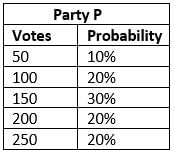
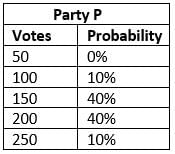
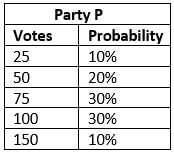
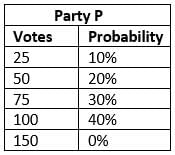
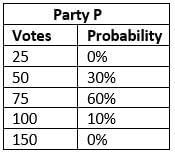
A country XYZ is facing election in the current year. There are 5 political parties in the country contesting for the election namely P, Q, R, S and T. Each of the party has certain mathematicians within them who have determined with great accuracy the probability of winning certain number of votes. The following table illustrates the probability as calculated by them for each of the party





Answer the following question based on the table given above. Assume that the prediction from mathematician is true at the end of election.
Q.If XYZ requires a minimum of 255 votes for the formation of Government and parties can combine with each other, then which two party coalitions from the choices given below can form a Government meeting the criteria required?
- a)P and R
- b)Q and S
- c)P and S
- d)Q and R
Correct answer is option 'D'. Can you explain this answer?

|
Explore Courses for CAT exam
|

|
Similar CAT Doubts
Answer the following question based on the information given below.A country XYZ is facing election in the current year. There are 5 political parties in the country contesting for the election namely P, Q, R, S and T. Each of the party has certain mathematicians within them who have determined with great accuracy the probability of winning certain number of votes. The following table illustrates the probability as calculated by them for each of the partyAnswer the following question based on the table given above. Assume that the prediction from mathematician is true at the end of election.Q.If XYZ requires a minimum of 255 votes for the formation of Government and parties can combine with each other, then which two party coalitions from the choices given below can form a Government meeting the criteria required?a)P and Rb)Q and Sc)P and Sd)Q and RCorrect answer is option 'D'. Can you explain this answer?
Question Description
Answer the following question based on the information given below.A country XYZ is facing election in the current year. There are 5 political parties in the country contesting for the election namely P, Q, R, S and T. Each of the party has certain mathematicians within them who have determined with great accuracy the probability of winning certain number of votes. The following table illustrates the probability as calculated by them for each of the partyAnswer the following question based on the table given above. Assume that the prediction from mathematician is true at the end of election.Q.If XYZ requires a minimum of 255 votes for the formation of Government and parties can combine with each other, then which two party coalitions from the choices given below can form a Government meeting the criteria required?a)P and Rb)Q and Sc)P and Sd)Q and RCorrect answer is option 'D'. Can you explain this answer? for CAT 2024 is part of CAT preparation. The Question and answers have been prepared according to the CAT exam syllabus. Information about Answer the following question based on the information given below.A country XYZ is facing election in the current year. There are 5 political parties in the country contesting for the election namely P, Q, R, S and T. Each of the party has certain mathematicians within them who have determined with great accuracy the probability of winning certain number of votes. The following table illustrates the probability as calculated by them for each of the partyAnswer the following question based on the table given above. Assume that the prediction from mathematician is true at the end of election.Q.If XYZ requires a minimum of 255 votes for the formation of Government and parties can combine with each other, then which two party coalitions from the choices given below can form a Government meeting the criteria required?a)P and Rb)Q and Sc)P and Sd)Q and RCorrect answer is option 'D'. Can you explain this answer? covers all topics & solutions for CAT 2024 Exam. Find important definitions, questions, meanings, examples, exercises and tests below for Answer the following question based on the information given below.A country XYZ is facing election in the current year. There are 5 political parties in the country contesting for the election namely P, Q, R, S and T. Each of the party has certain mathematicians within them who have determined with great accuracy the probability of winning certain number of votes. The following table illustrates the probability as calculated by them for each of the partyAnswer the following question based on the table given above. Assume that the prediction from mathematician is true at the end of election.Q.If XYZ requires a minimum of 255 votes for the formation of Government and parties can combine with each other, then which two party coalitions from the choices given below can form a Government meeting the criteria required?a)P and Rb)Q and Sc)P and Sd)Q and RCorrect answer is option 'D'. Can you explain this answer?.
Answer the following question based on the information given below.A country XYZ is facing election in the current year. There are 5 political parties in the country contesting for the election namely P, Q, R, S and T. Each of the party has certain mathematicians within them who have determined with great accuracy the probability of winning certain number of votes. The following table illustrates the probability as calculated by them for each of the partyAnswer the following question based on the table given above. Assume that the prediction from mathematician is true at the end of election.Q.If XYZ requires a minimum of 255 votes for the formation of Government and parties can combine with each other, then which two party coalitions from the choices given below can form a Government meeting the criteria required?a)P and Rb)Q and Sc)P and Sd)Q and RCorrect answer is option 'D'. Can you explain this answer? for CAT 2024 is part of CAT preparation. The Question and answers have been prepared according to the CAT exam syllabus. Information about Answer the following question based on the information given below.A country XYZ is facing election in the current year. There are 5 political parties in the country contesting for the election namely P, Q, R, S and T. Each of the party has certain mathematicians within them who have determined with great accuracy the probability of winning certain number of votes. The following table illustrates the probability as calculated by them for each of the partyAnswer the following question based on the table given above. Assume that the prediction from mathematician is true at the end of election.Q.If XYZ requires a minimum of 255 votes for the formation of Government and parties can combine with each other, then which two party coalitions from the choices given below can form a Government meeting the criteria required?a)P and Rb)Q and Sc)P and Sd)Q and RCorrect answer is option 'D'. Can you explain this answer? covers all topics & solutions for CAT 2024 Exam. Find important definitions, questions, meanings, examples, exercises and tests below for Answer the following question based on the information given below.A country XYZ is facing election in the current year. There are 5 political parties in the country contesting for the election namely P, Q, R, S and T. Each of the party has certain mathematicians within them who have determined with great accuracy the probability of winning certain number of votes. The following table illustrates the probability as calculated by them for each of the partyAnswer the following question based on the table given above. Assume that the prediction from mathematician is true at the end of election.Q.If XYZ requires a minimum of 255 votes for the formation of Government and parties can combine with each other, then which two party coalitions from the choices given below can form a Government meeting the criteria required?a)P and Rb)Q and Sc)P and Sd)Q and RCorrect answer is option 'D'. Can you explain this answer?.
Solutions for Answer the following question based on the information given below.A country XYZ is facing election in the current year. There are 5 political parties in the country contesting for the election namely P, Q, R, S and T. Each of the party has certain mathematicians within them who have determined with great accuracy the probability of winning certain number of votes. The following table illustrates the probability as calculated by them for each of the partyAnswer the following question based on the table given above. Assume that the prediction from mathematician is true at the end of election.Q.If XYZ requires a minimum of 255 votes for the formation of Government and parties can combine with each other, then which two party coalitions from the choices given below can form a Government meeting the criteria required?a)P and Rb)Q and Sc)P and Sd)Q and RCorrect answer is option 'D'. Can you explain this answer? in English & in Hindi are available as part of our courses for CAT.
Download more important topics, notes, lectures and mock test series for CAT Exam by signing up for free.
Here you can find the meaning of Answer the following question based on the information given below.A country XYZ is facing election in the current year. There are 5 political parties in the country contesting for the election namely P, Q, R, S and T. Each of the party has certain mathematicians within them who have determined with great accuracy the probability of winning certain number of votes. The following table illustrates the probability as calculated by them for each of the partyAnswer the following question based on the table given above. Assume that the prediction from mathematician is true at the end of election.Q.If XYZ requires a minimum of 255 votes for the formation of Government and parties can combine with each other, then which two party coalitions from the choices given below can form a Government meeting the criteria required?a)P and Rb)Q and Sc)P and Sd)Q and RCorrect answer is option 'D'. Can you explain this answer? defined & explained in the simplest way possible. Besides giving the explanation of
Answer the following question based on the information given below.A country XYZ is facing election in the current year. There are 5 political parties in the country contesting for the election namely P, Q, R, S and T. Each of the party has certain mathematicians within them who have determined with great accuracy the probability of winning certain number of votes. The following table illustrates the probability as calculated by them for each of the partyAnswer the following question based on the table given above. Assume that the prediction from mathematician is true at the end of election.Q.If XYZ requires a minimum of 255 votes for the formation of Government and parties can combine with each other, then which two party coalitions from the choices given below can form a Government meeting the criteria required?a)P and Rb)Q and Sc)P and Sd)Q and RCorrect answer is option 'D'. Can you explain this answer?, a detailed solution for Answer the following question based on the information given below.A country XYZ is facing election in the current year. There are 5 political parties in the country contesting for the election namely P, Q, R, S and T. Each of the party has certain mathematicians within them who have determined with great accuracy the probability of winning certain number of votes. The following table illustrates the probability as calculated by them for each of the partyAnswer the following question based on the table given above. Assume that the prediction from mathematician is true at the end of election.Q.If XYZ requires a minimum of 255 votes for the formation of Government and parties can combine with each other, then which two party coalitions from the choices given below can form a Government meeting the criteria required?a)P and Rb)Q and Sc)P and Sd)Q and RCorrect answer is option 'D'. Can you explain this answer? has been provided alongside types of Answer the following question based on the information given below.A country XYZ is facing election in the current year. There are 5 political parties in the country contesting for the election namely P, Q, R, S and T. Each of the party has certain mathematicians within them who have determined with great accuracy the probability of winning certain number of votes. The following table illustrates the probability as calculated by them for each of the partyAnswer the following question based on the table given above. Assume that the prediction from mathematician is true at the end of election.Q.If XYZ requires a minimum of 255 votes for the formation of Government and parties can combine with each other, then which two party coalitions from the choices given below can form a Government meeting the criteria required?a)P and Rb)Q and Sc)P and Sd)Q and RCorrect answer is option 'D'. Can you explain this answer? theory, EduRev gives you an
ample number of questions to practice Answer the following question based on the information given below.A country XYZ is facing election in the current year. There are 5 political parties in the country contesting for the election namely P, Q, R, S and T. Each of the party has certain mathematicians within them who have determined with great accuracy the probability of winning certain number of votes. The following table illustrates the probability as calculated by them for each of the partyAnswer the following question based on the table given above. Assume that the prediction from mathematician is true at the end of election.Q.If XYZ requires a minimum of 255 votes for the formation of Government and parties can combine with each other, then which two party coalitions from the choices given below can form a Government meeting the criteria required?a)P and Rb)Q and Sc)P and Sd)Q and RCorrect answer is option 'D'. Can you explain this answer? tests, examples and also practice CAT tests.

|
Explore Courses for CAT exam
|

|
Suggested Free Tests
Signup for Free!
Signup to see your scores go up within 7 days! Learn & Practice with 1000+ FREE Notes, Videos & Tests.
























